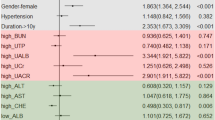Abstract
This study aims to identify the predictive value of cystatin C for diabetic retinopathy (DR) in Chinese patients with type 2 diabetes. Data from a cross-sectional hospital-based survey of 450 type 2 diabetes patients were analyzed in the study. DR was assessed by fundus fluorescein angiography. Duration of diabetes and other related information were obtained by questionnaire. Body mass index, blood pressure, HbA1c, cystatin C, glomerular filtration rate, urinary albumin excretion, blood lipids, and uric acid were measured. Binary logistic regression was performed to evaluate potential risk factors for DR. The predictive value of cystatin C for DR was evaluated using ROC curve. Cystatin C (P = 0.039) was a risk factor for DR after GFR, and other possibly related variables were adjusted. Cystatin C had a significant predictive value for any DR (AUC, 0.763, P < 0.001; optimal cutoff value, 1.11 mg/L; sensitivity, 56.00 %; specificity, 83.90 %) or severe DR (AUC, 0.821, P < 0.001; optimal cutoff value, 1.23 mg/L; sensitivity, 73.60 %; specificity, 88.70 %). Cystatin C is a novel risk factor for DR and should be used to screen and forecast the presence of DR (especially severe DR) in Chinese patients with type 2 diabetes. The association between cystiatin C and DR should not depend on the excellent ability of cystatin C for the estimation of GFR.



Similar content being viewed by others
References
Kocur I, Resnikoff S. Visual impairment and blindness in Europe and their prevention. Br J Ophthalmol. 2002;86:716–22.
Hirsch IB, Brownlee M. Beyond hemoglobin A1c-need for additional markers of risk factor for diabetic microvascular complications. JAMA. 2010;303:2291–2.
Pucci L, Triscornia S, Lucchesi D, Fotino C, Pellegrini G, Pardini E, et al. Cystatin C and estimates of renal function: searching for a better measure of kidney function in diabetic patients. Clin Chem. 2007;53:480–8.
Jeon YK, Kim MR, Huh JE, Mok JY, Song SH, Kim SS, et al. Cystatin C as an early biomarker of nephropathy in patients with type 2 diabetes. J Korean Med Sci. 2011;26:258–63.
He R, Shen J, Zhao J, Zeng H, Li LX, Zhao JG, et al. High Cystatin C levels predict severe retinopathy in type 2 diabetes patients. Eur J Epidemiol. 2013;28:775–8.
Namperumalsamy P, Nirmalan PK, Ramasamy K. Developing a screening program to detect sight-threatening diabetic retinopathy in South India. Diabetes Care. 2003;26:1831–5.
Zhang H, Wang J, Ying GS, Shen L, Zhang Z. Diabetic retinopathy and renal function in Chinese type 2 diabetic patients. Int Urol Nephrol. 2014;46:1375–81.
Wilkinson CP, Ferris 3rd FL, Klein RE, Lee PP, Agardh CD, Davis M, et al. Proposed international clinical diabetic retinopathy and diabetic macular edema disease severity scales. Ophthalmology. 2003;110:1677–82.
Bandello F, Lattanzio R, Zucchiatti I, Del Turco C. Pathophysiology and treatment of diabetic retinopathy. Acta Diabetol. 2013;50:1–20.
Spranger J, Kroke A, Möhlig M, Hoffmann K, Bergmann MM, Ristow M, et al. Inflammatory cytokines and the risk to develop type 2 diabetes: results of the prospective population-based European Prospective Investigation into Cancer and Nutrition (EPIC)-Potsdam Study. Diabetes. 2003;52:812–7.
Gardner TW, Antonetti DA, Barber AJ, Lanoue KF, Nakamura M. New insights into the pathophysiology of diabetic retinopathy: potential cell-specific therapeutic targets. Diabetes Technol Ther. 2000;2:601–4.
Yuuki T, Kanda T, Kimura Y, Kotajima N, Tamura J, Kobayashi I, et al. Inflammatory cytokines in vitreous fluid and serum of patients with diabetic vitreoretinopathy. J Diabetes Complications. 2001;15:257–9.
Paraoan L, Hiscott P, Gosden C, Grierson I. Cystatin C in macular and neuronal degenerations: implications for mechanism(s) age-related macular degeneration. Vis Res. 2010;50:737–42.
Wassélius J, Johansson K, Håkansson K, Abrahamson M, Ehinger B. Cystatin C uptake in the eye. Graefes Arch Clin Exp Ophthalmol. 2005;243:583–92.
Van Hecke MV, Dekker JM, Nijpels G, Moll AC, Heine RJ, Bouter LM, et al. Inflammation and endothelial dysfunction are associated with retinopathy: the Hoorn Study. Diabetologia. 2005;48:1300–6.
Taglieri N, Koenig W, Kaski JC. Cystatin C and cardiovascular risk. Clin Chem. 2009;55:1932–43.
Mussap M, Plebani M. Biochemistry and clinical role of human Cystatin C. Crit Rev Clin Lab Sci. 2004;41:467–550.
The Diabetic Retinopathy Study Research Group. Preliminary report on the effects of photocoagulation therapy. Am J Ophthalmol. 1976;81:383–96.
The Diabetic Retinopathy Study Research Group. Photocoagulation treatment of proliferative diabetic retinopathy; clinical applications of Diabetic Retinopathy Study. Ophthalmology. 1981;88:583–600.
Pavkov ME, Knowler WC, Lemley KV, Mason CC, Myers BD, Nelson RG. Early renal function decline in type 2 diabetes. Clin J Am Soc Nephrol. 2012;7:78–84.
Hu A, Luo Y, Guo XB, Ding XY, Zhu XB, Wang XQ, et al. Low serum apolipoprotein A1/B ratio is associated with proliferative diabetic retinopathy in type 2 diabetes. Graefes Arch Clin Exp Ophthalmol. 2012;250:957–62.
Sasongko MB, Wong TY, Nguyen TT, Shaw JE, Jenkins AJ, Wang JJ. Novel versus traditional risk markers for diabetic retinopathy. Diabetologia. 2012;55:666–70.
Deguchi Y, Maeno T, Saishin Y, Hori Y, Shiba T, Takahashi M. Relevance of the serum apolipoprotein ratio to diabetic retinopathy. Jpn J Ophthalmol. 2011;55:128–31.
Cheung N, Mitchell P, Wong TY. Diabetic retinopathy. Lancet. 2010;376:124–36.
Acknowledgments
This study was supported by grants from the research development program of Shandong provincial higher schools of China (Project Number: J12LM61).
Conflict of interest
The authors declare that they have no conflicts of interest.
Author information
Authors and Affiliations
Corresponding author
Rights and permissions
About this article
Cite this article
Sun, S., Li, M., Zhou, J. et al. Cystatin C predicts diabetic retinopathy in Chinese patients with type 2 diabetes. Int J Diabetes Dev Ctries 35 (Suppl 3), 398–404 (2015). https://doi.org/10.1007/s13410-015-0383-3
Received:
Accepted:
Published:
Issue Date:
DOI: https://doi.org/10.1007/s13410-015-0383-3




